Road Trip Essentials for Dogs: A Guide to Safe and Happy Travels With Your Canine Companion
Embarking on a road trip with your dog offers a chance to bond and explore new destinations together. To ensure a safe and comfortable journey for your four-legged companion, it’s crucial to pack the right items. Just as you would meticulously prepare your own travel essentials, considering the specific needs of your pet is equally important. From hydration to entertainment, every detail counts when you’re setting off on an adventure with your canine friend.
Traveling by car with a dog requires planning around their routine and comfort. Packing must-haves such as food, water, and bowls are just the start. You’ll also need to think about securing your pet during the drive, managing bathroom breaks effectively, and ensuring they have a cozy place to rest during pit stops or at your final destination. Whether it’s a short drive to a nearby hiking trail or a cross-country expedition, the gear you bring will have a big impact on your dog’s travel experience.
Your dog’s health and safety are paramount, which means preparing for any scenario. A first-aid kit tailored to your dog, medications if they require any, and up-to-date identification tags should be on your packing list. Familiar toys and a blanket can help alleviate stress by providing comfort and a sense of normalcy. Balancing practical items with those that support your dog’s mental and physical well-being will set the stage for an enjoyable and memorable road trip together.
Preparing Your Dog for Travel
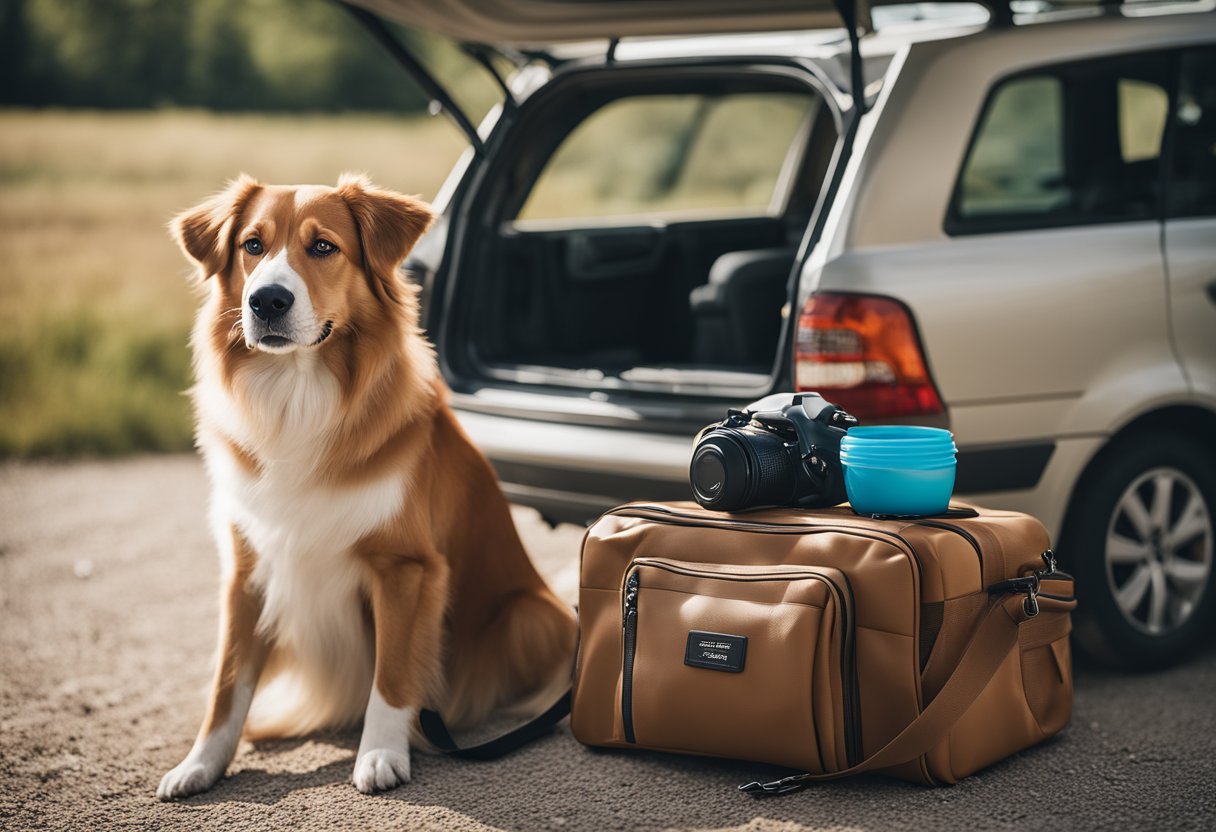
Before setting out on a trip with your dog, it’s essential to address identification, training, and health requirements to ensure a safe and stress-free journey.
Identification and Documentation
Identification Tags & Microchip: Ensure your dog wears a collar with up-to-date identification tags. The tags should include your dog’s name, your phone number, and proof of rabies vaccination. It’s also wise to have your dog microchipped, which can be a lifeline in case the collar comes off.
| Documentation | Description |
|---|---|
| Vaccination Records | Carry a copy of your dog’s vaccination records, especially for rabies, as this is often required for accommodations and dog-friendly venues. |
| Health Certificate | If crossing state lines or entering another country, obtain a health certificate from your vet within ten days of travel. |
Desensitization and Training
- Short Drives: Start with short drives to familiarize your dog with the car. Gradually increase the length of time spent in the car to help your dog become comfortable with longer trips.
- Secure Riding: Train your dog to ride securely in a crate or with a dog seat belt to prevent injury during sudden stops and turns.
Health Precautions
- Medication and First Aid: Pack any medications your dog needs, along with a basic pet first aid kit. Be aware of your dog’s health needs and be prepared to address them.
- Pre-Travel Veterinary Visit: Schedule a visit to the vet to ensure your dog is healthy for travel and to discuss any concerns about motion sickness or anxiety. Your vet may recommend medications or strategies to make travel more comfortable for your dog.
Dog Travel Kit
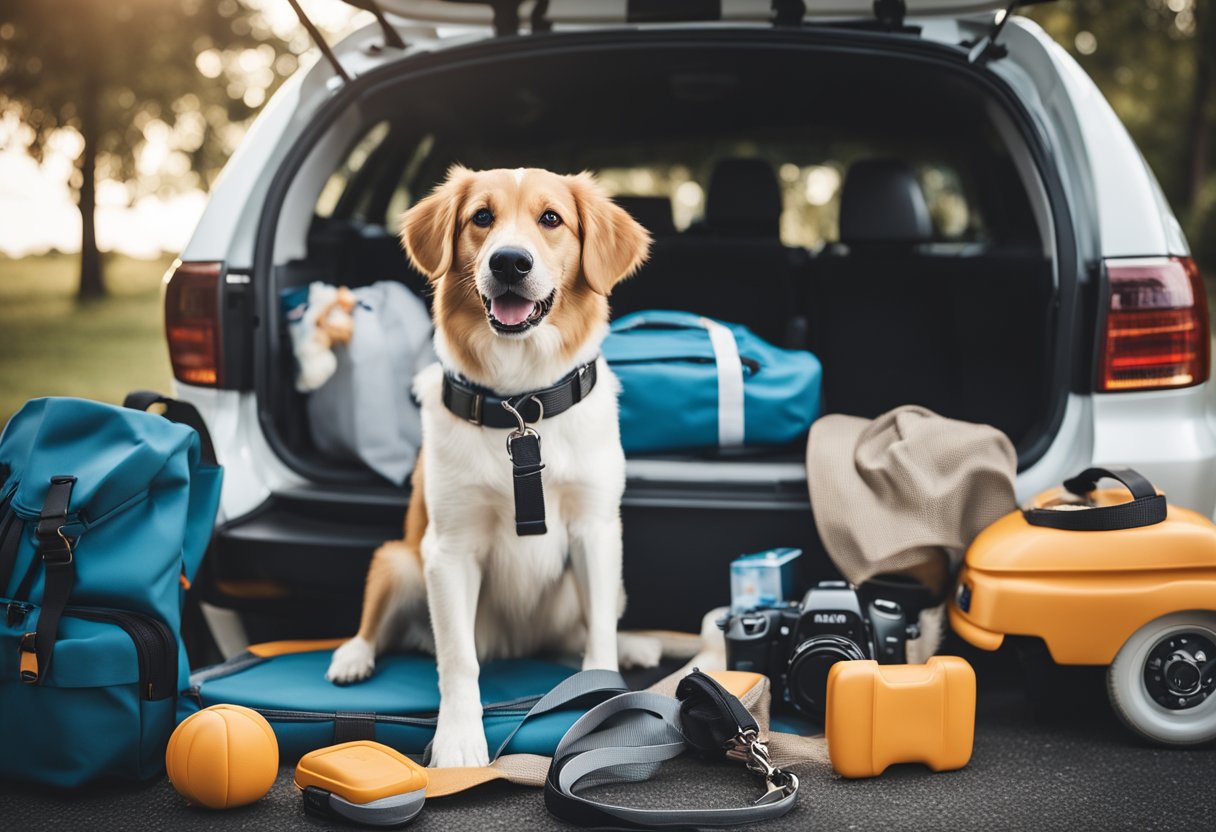
A well-prepared dog travel kit ensures your pet’s needs are met during a road trip. Each item in the kit should make your journey with your dog safer and more enjoyable.
Food and Water Supplies
Your dog will require a steady supply of their usual food to avoid any stomach upsets. Pack enough for the entire trip and a little extra, just in case. For water, bring a sufficient amount for the journey, plus any stops along the way.
- Food: Pack individual meal servings in zip-lock bags.
- Water: Carry at least one gallon for multiple days of travel.
Bowls and Feeding Accessories
Feeding your dog on the go is simplified with the right accessories.
- Bowls: Collapsible bowls are space-efficient and ideal for travel.
- Feeding Mats: Use a silicone mat to keep feeding areas clean.
Leashes and Harnesses
A sturdy leash and harness are vital for controlling and protecting your dog in new environments.
- Leash: Strong, adjustable, with a comfortable grip.
- Harness: Proper fit to prevent escape or discomfort.
Waste Management Essentials
Responsible waste management keeps rest areas clean and minimizes impact on the environment.
- Poop Bags: Biodegradable bags are a responsible choice.
- Portable Waste Scooper: Compact scoopers can fit in any travel bag.
Safety Gear
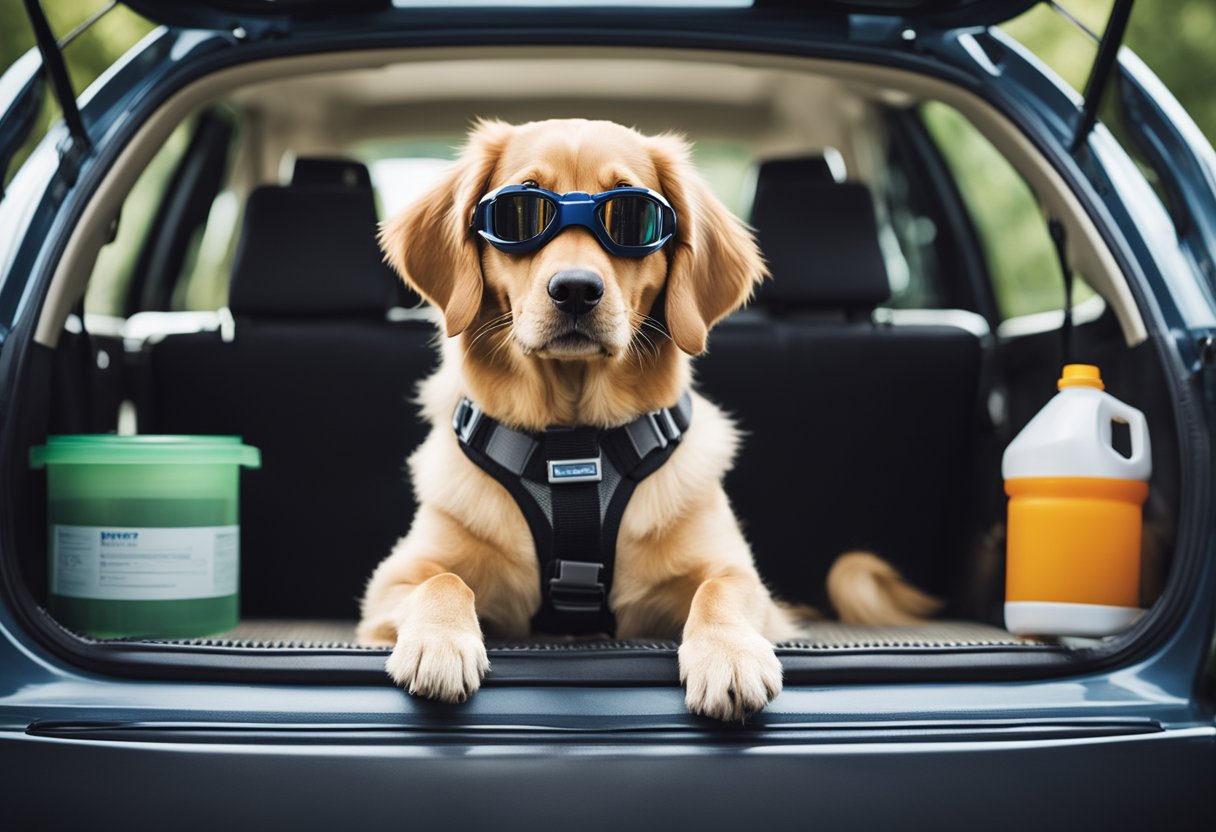
When preparing for a road trip with your dog, ensuring their safety is paramount. Equipping your vehicle with the right safety gear can prevent injuries and provide peace of mind during your journey.
Crash-Tested Crates
A crash-tested crate is designed to withstand the forces of a collision and provide a secure environment for your dog. Look for crates that have passed rigorous testing from organizations such as the Center for Pet Safety (CPS). These crates often feature:
- Reinforced walls: Strong materials resist crumbling upon impact.
- Proper ventilation: Ensures your dog can breathe comfortably.
- Appropriate sizing: Select a crate that allows your dog to stand, turn, and lie down.
Dog Seat Belts
Dog seat belts, similar to human safety belts, keep your dog in place during travel. They attach to your dog’s harness and the vehicle’s seatbelt system. Key features include:
- Adjustable straps: Fit can be tailored to your dog’s size.
- Padded chest plates: Provide comfort and protection.
- Durability: Made from strong materials to resist breaking.
Travel Barriers
Travel barriers prevent your dog from moving between the car’s areas, reducing driver distraction and increasing safety. They come in various forms, such as:
- Mesh or metal grids: Choose based on your dog’s size and the level of visibility you prefer.
- Customizable fit: Many barriers are adjustable to fit a range of vehicles.
Comfort Items
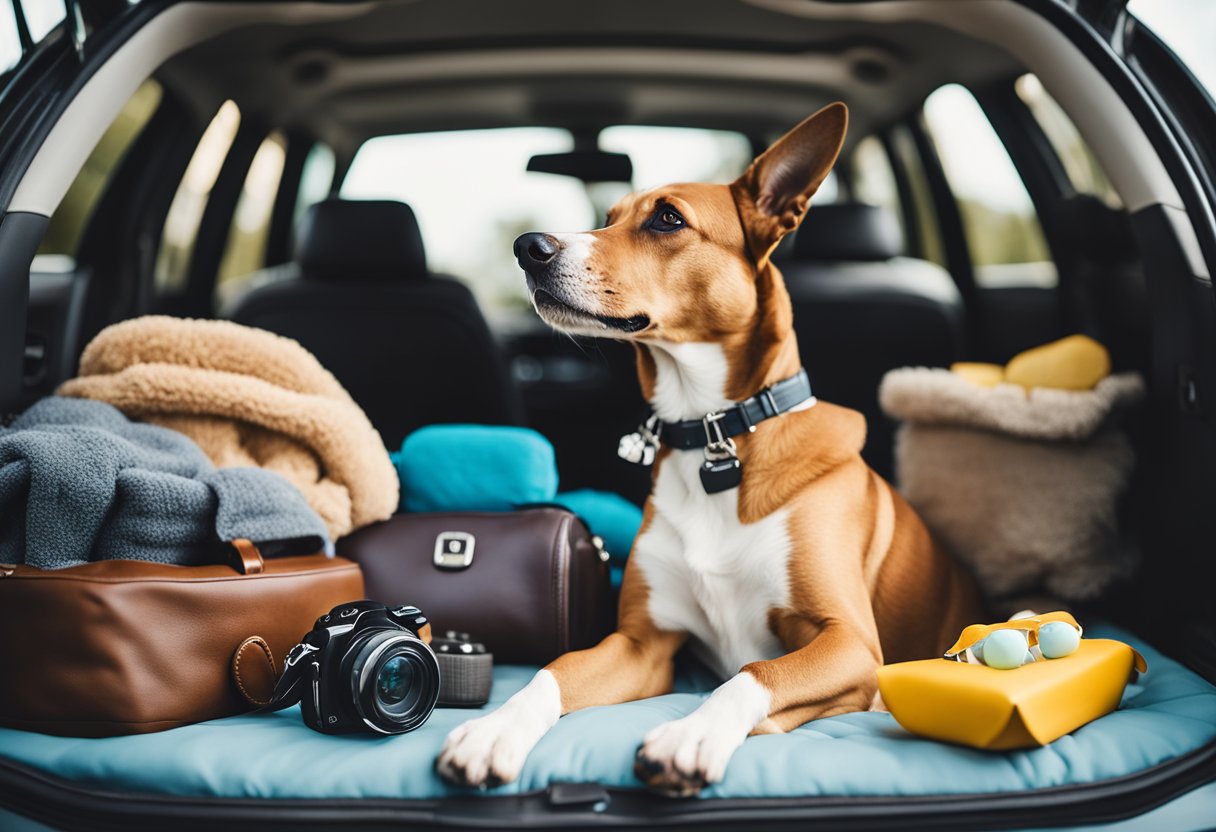
When preparing for a road trip with your dog, comfort items are key. These familiar objects provide a sense of security and help ease your dog’s stress during travel.
Beds and Blankets
Beds: You’ll want to bring your dog’s bed to give them a familiar and comfortable place to rest. Opt for a portable, washable bed that fits well in your vehicle.
Blankets: Pack a blanket that smells like home for added comfort. An extra blanket may also be used to cover and protect your vehicle’s seats.
Toys and Chewables
Toys: Bring your dog’s favorite toys to keep them occupied. Make sure they are durable and safe for unsupervised chewing.
Chewables: Offer your dog chewable toys or treats that can last for a while, keeping them engaged and happy during the trip.
Calming Aids
Pheromone Sprays: Sprays that mimic calming pheromones can reduce anxiety and help your dog relax.
Music/Sounds: A playlist of soothing music or white noise can keep the car ride tranquil for your dog.
Healthcare
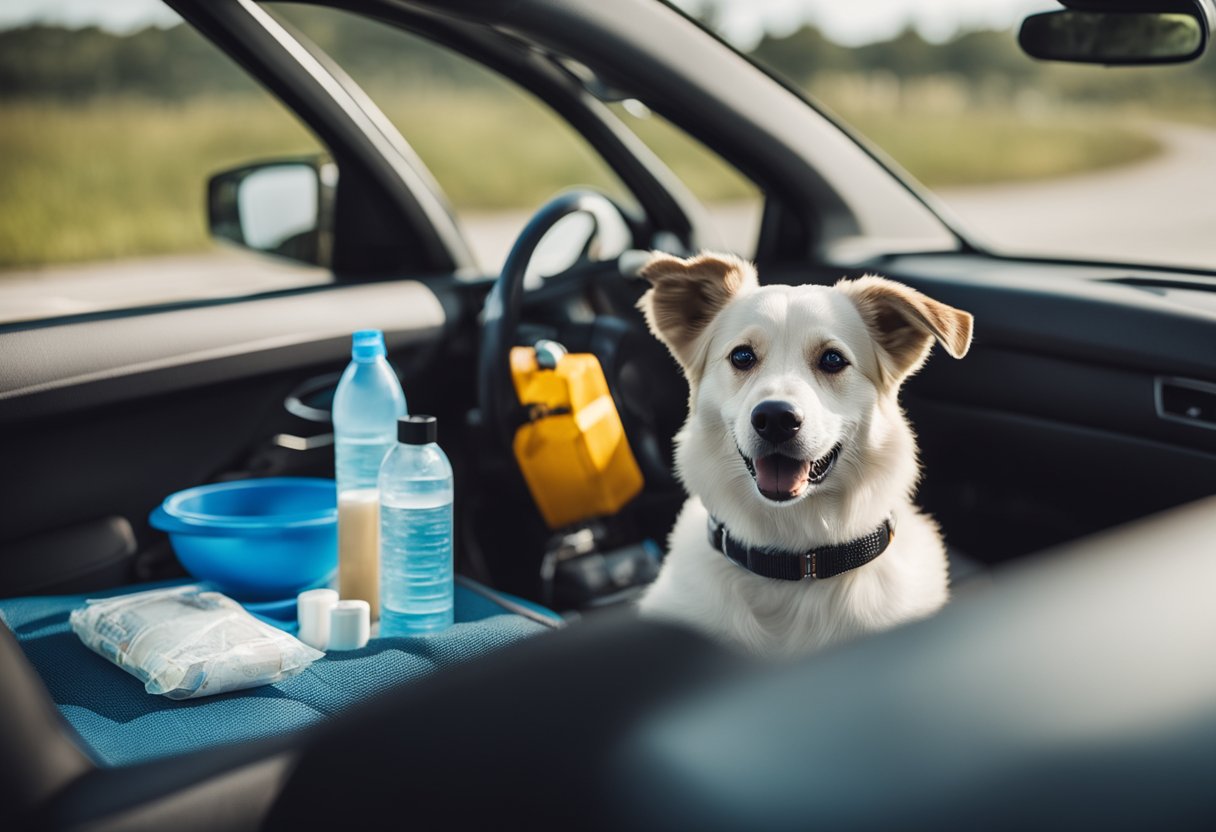
When preparing for a road trip with your dog, prioritize their health needs as you would your own. A well-stocked first-aid kit, current medications and supplements, and tick and flea prevention are essential for your dog’s safety and well-being.
First-Aid Kit
Your dog’s first-aid kit should include:
- Gauze, for wrapping wounds or muzzling the injured pet
- Adhesive tape, for bandages
- Cotton balls or swabs
- Antiseptic wipes or spray
- Tweezers, for removing splinters or ticks
- Scissors with blunt ends
- Disposable gloves
- Ice pack
- Thermometer (remember that a dog’s normal body temperature ranges from 101–102.5°F, or 38.3–39.2°C)
Medications and Supplements
Ensure all prescribed medications include:
- Prescribed medications, clearly labeled with dosage instructions
- Supplements, if your dog regularly takes them
- A pill dispenser or treats to help administer tablets
Always bring a few days’ extra supply in case your trip is unexpectedly extended.
Tick and Flea Prevention
Preventative measures are necessary, especially when traveling to areas with high tick and flea populations. Maintain your regular prevention routine with products such as:
- Topical treatments, applied directly to your dog’s skin
- Oral medications, which can be given as chewable tablets
- Tick and flea collars, offering long-term protection
Remember to check your dog for ticks and fleas daily, especially after outdoor activities.
Accommodation Planning
When planning a road trip with your dog, it is crucial to consider where you’ll be able to stop along the way and where you’ll stay. This ensures a smooth journey for both you and your pet.
Pet-Friendly Stops
Identify rest areas and parks where your dog can stretch and relieve themselves. Look for stops with:
- Adequate fencing: Check if the area is secure, preventing your dog from accidentally running into traffic.
- Shade and water: Ensure there are shaded spots and fresh water available to keep your dog cool and hydrated.
Maps and travel apps can help you locate these pet-friendly spots along your route.
Emergency Vet Clinics
Research and list emergency veterinary clinics located along your route. Consider including:
- Contact information: Write down phone numbers and addresses.
- Operating hours: Note the hours they are open, including 24/7 facilities.
Keep this list easily accessible during your trip.
Overnight Stays
Book accommodations in advance at hotels or motels that openly welcome pets. Confirm:
- Pet policies: Verify if there are additional fees or restrictions based on size or breed.
- Amenities for pets: Check if they provide dog beds, bowls, or a designated walking area.
Use online booking platforms that filter for pet-friendly accommodations to streamline your search.
Climate and Environment Adaptation
When traveling with your dog, adapting to different climates and environments is crucial for their comfort and safety. Below are specific items and strategies to consider based on the conditions you’ll encounter.
Appropriate Clothing
- Cold Climates: Ensure your dog has a water-resistant coat if heading into cold, wet areas. For breeds sensitive to cold, an insulated jacket is advisable.
- Warm Climates: For sunny locations, a light-colored, breathable sunshirt can protect against UV rays while keeping your dog cool.
Cooling or Heating Aids
- Cooling Aids:
- Cooling vests can be soaked in water to provide relief from heat.
- Cooling mats offer a portable surface to help maintain a comfortable body temperature.
- Heating Aids:
- Self-warming pads reflect the dog’s body heat.
- Portable heaters should be used with caution and never left unsupervised.
Paw Protection
- Rugged Terrain: Durable booties protect against sharp rocks and rough surfaces.
- Hot pavement: To avoid burns, use heat-resistant booties and walk your dog during cooler times of the day.
- Snow and Ice: Insulated booties with grip are essential to prevent frostbite and slipping.
Travel Etiquette and Training
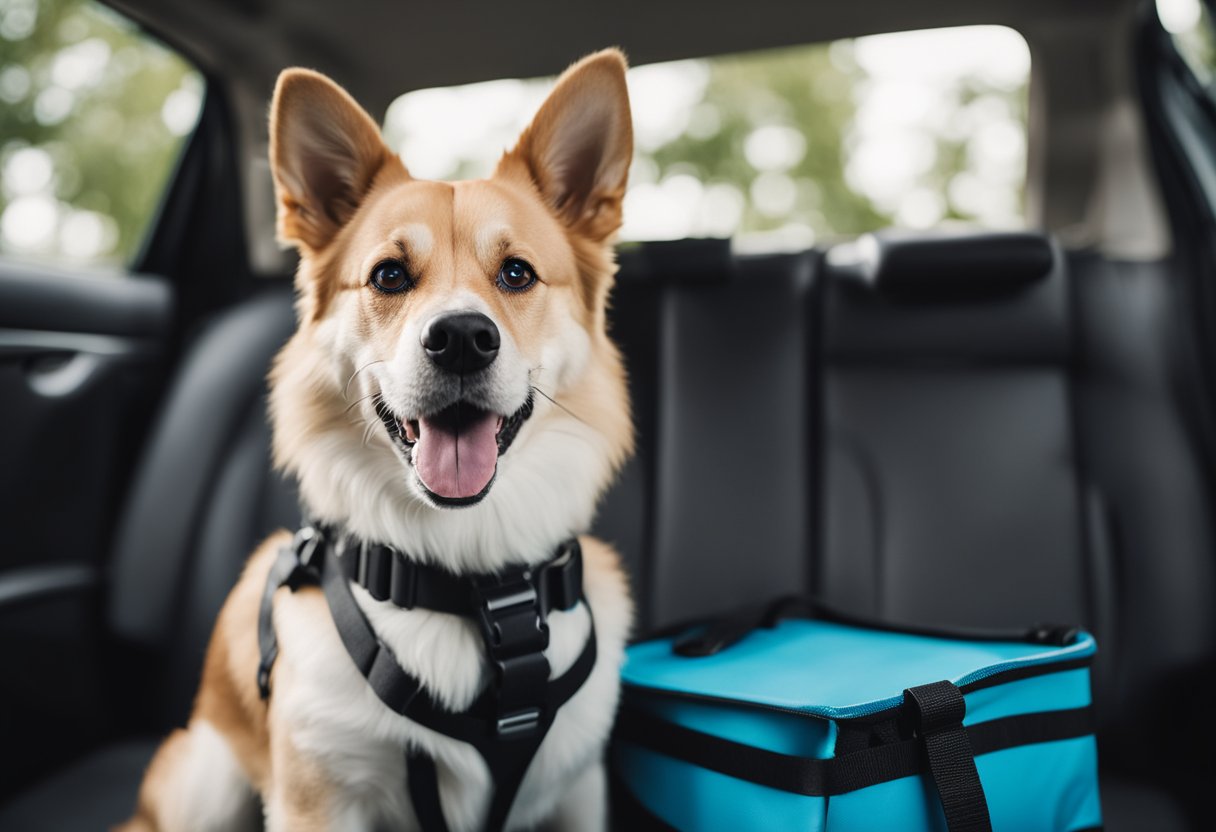
Proper training and understanding of etiquette are crucial for ensuring a pleasant and safe road trip with your dog.
Behavioral Commands
Before embarking on a road trip, your dog should be proficient in basic commands such as sit, stay, come, and quiet. These commands help manage your dog’s behavior in the car and during stops.
- Sit & Stay: Utilize these commands to prevent your dog from moving around the vehicle or darting out when doors open.
- Come: Essential for recall if they accidentally get loose.
- Quiet: Helps keep your dog calm and prevents barking at unfamiliar sights or sounds.
Rest Stop Etiquette
At rest stops, it is your responsibility to ensure your dog behaves appropriately.
Leash: Always keep your dog leashed for control and as required by law in public areas.
| Behavior | Do | Don’t |
|---|---|---|
| Leash Walking | Keep a tight grip | Let your dog wander |
| Waste Disposal | Clean up immediately | Leave waste behind |
| Interaction Areas | Use designated pet areas | Allow roaming freely |
Interactions with Strangers
Interacting with strangers can be unpredictable, so it’s important to manage these situations carefully.
- Ask First: If someone wants to pet your dog, instruct them to ask first.
- Close Watch: Maintain a close watch on your dog’s body language to prevent any unwanted interactions.
- Space: Respect the space of others by not allowing your dog to approach them without invitation.
Journey Documentation
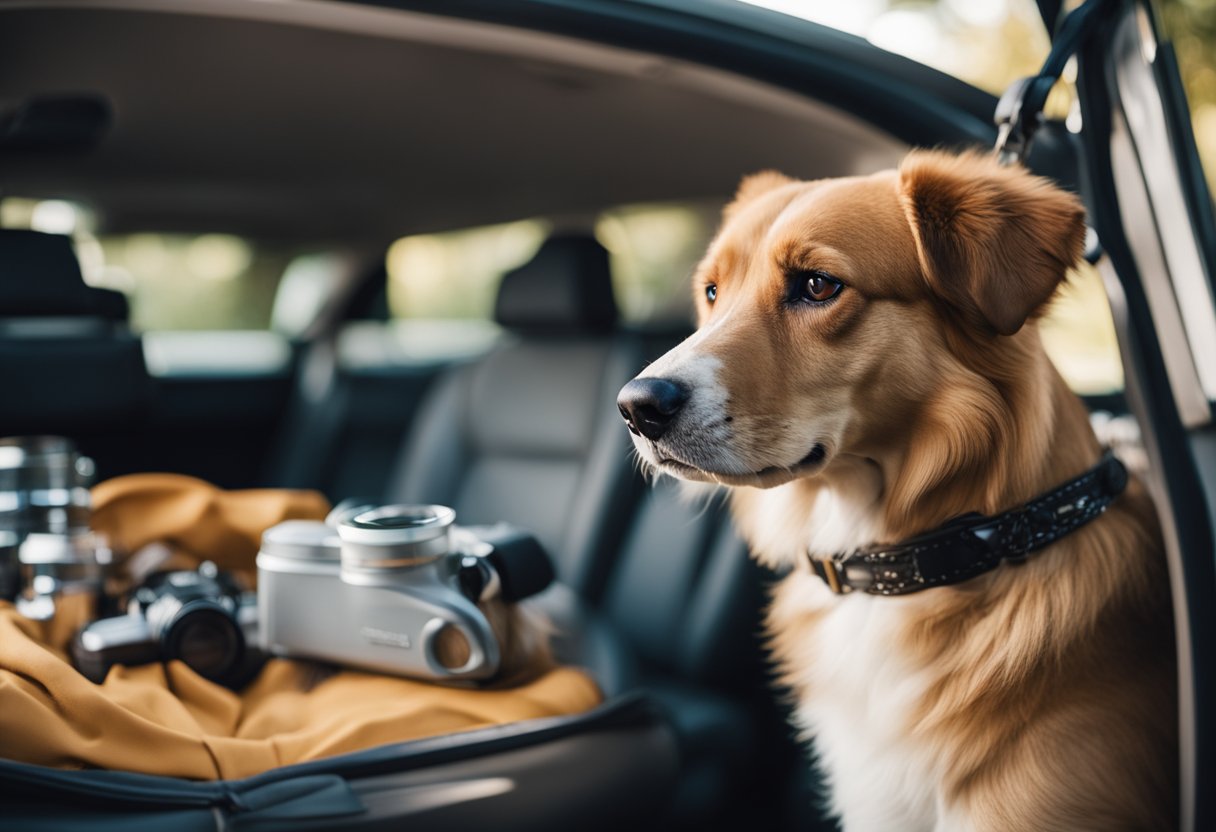
When embarking on a road trip with your dog, it’s essential to document your journey for both memories and practical purposes. Properly maintaining a record can ensure you capture precious moments and have necessary information readily available.
Photographs and Updates
- Photographs: Keep a digital or physical album of your dog’s road trip adventures. Photos serve as a wonderful reminder and can be useful to identify your pet if they get lost.
Destination Photo Description Date Taken Grand Canyon Dog gazing into the canyon MM/DD/YYYY Lake Tahoe Dog swimming MM/DD/YYYY - Updates: Regularly update friends or family members about your whereabouts. Use text, social media, or a dedicated app to provide these updates.
Update Method Interval Information Included Social Media Post Daily Current location, mood Family Text Every 2-3 days Health status, next stop
Travel Diary
- Written Log: Maintain a written diary detailing dates, places visited, and any dog-related incidences (such as vet visits).
Example Diary Entry:
Date: MM/DD/YYYY
Location: Yellowstone National Park
Event: Short hike trail, encountered wildlife. - Digital Log: Alternatively, use a digital note-taking app to create entries for quick reference and sharing capabilities.
App Suggestion:
- Evernote
- Google Keep
Frequently Asked Questions
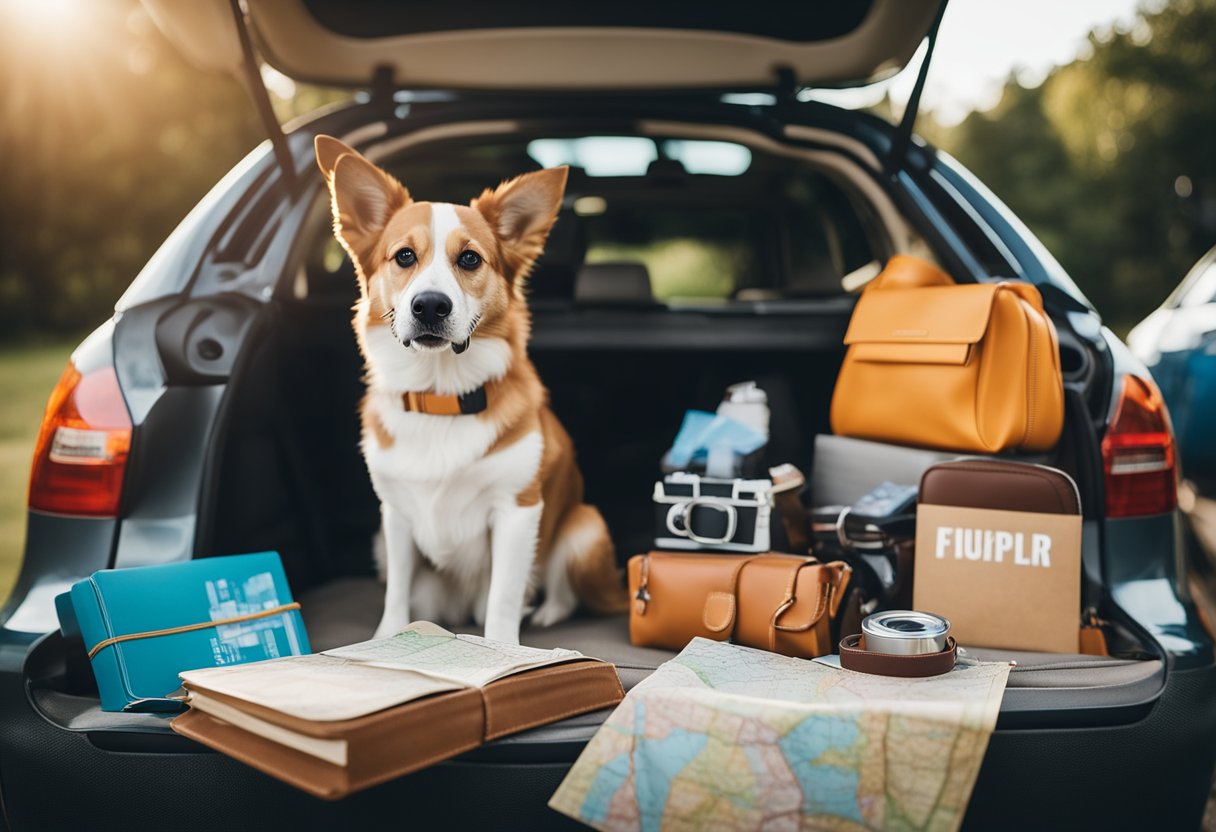
Preparing for a road trip with your dog involves understanding their needs and ensuring their safety and comfort. These common questions will guide you through the essentials of traveling with your pet.
What are the must-have items when packing for a dog on a road trip?
Your packing list should include a leash, collar with ID tags, water bottle, dog food, bowls, waste bags, and a comfortable pet carrier or harness. Don’t forget any medications your dog may need.
How do you ensure your dog’s comfort during long car journeys?
Ensure the car temperature is moderate, not too hot or cold. Use a dog seat cover or a travel bed to give your dog a familiar and comfortable space. Regular stops can also help your dog manage the stress of long journeys.
What are the best dog toys to keep a pet entertained during road trips?
Opt for durable chew toys, interactive puzzle toys, or familiar favorites that are safe for car travel. Toys should not pose a choking hazard and should be suitable for unsupervised play.
What is the recommended frequency for stopping to allow a dog to relieve itself on long road trips?
Stopping every 2-4 hours is recommended to allow your dog to relieve itself and stretch its legs. Adjust the frequency based on your dog’s age, breed, and usual routine.
How can one safely use over-the-counter sedatives for dogs when traveling by car?
Consult with a veterinarian before using sedatives for travel. Follow the prescribed dosage and consider a trial run before the trip to observe your dog’s reaction to the medication.
What are some suitable snack options for dogs when on a road trip?
Bring along dog-specific treats or kibble that your dog tolerates well. Avoid foods that are unfamiliar or not part of their regular diet to prevent stomach upset. Always have fresh water available.

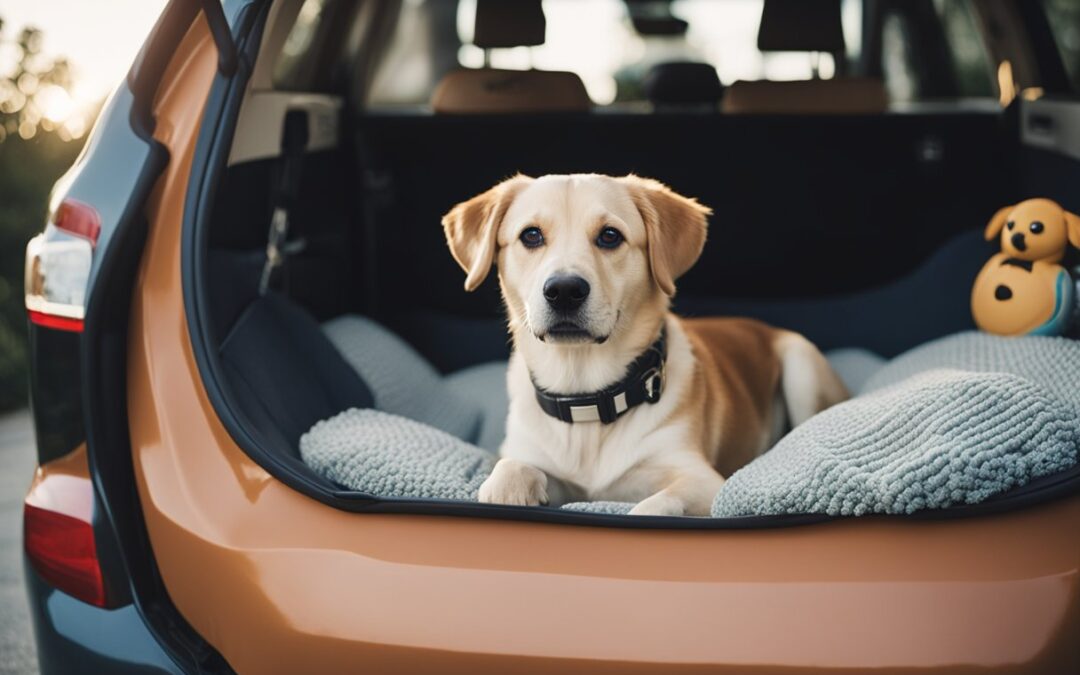

Recent Comments